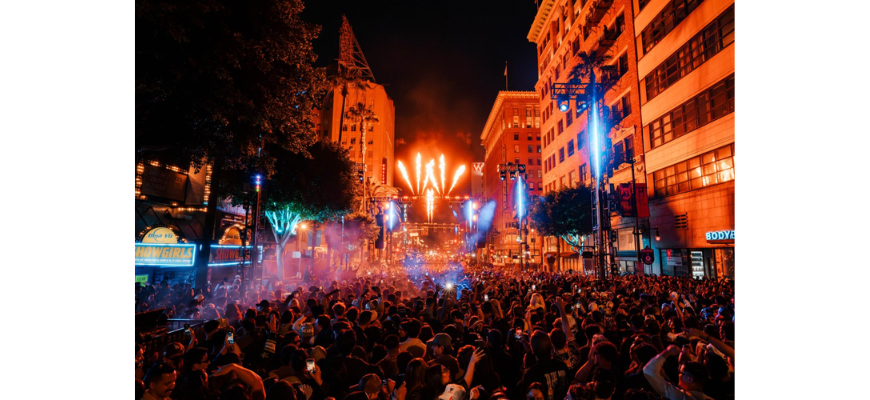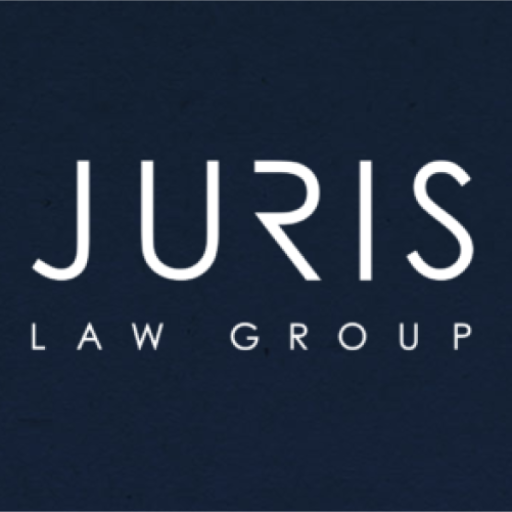
Last week, LA Weekly profiled how Kobi Danan and Framework have turned Los Angeles into a bona fide global dance music capital—running Sound (DJ Mag Top 100 Club), Spotlight (a hyper-intimate 200-cap room), the Yuma Tent at Coachella, Framework in the Desert, and city‑scale takeovers like Hollywood Blvd. The firm’s partnership web is wide: Goldenvoice (Shrine, Fonda), Wynn Nightlife (Art of the Wild, Las Vegas), and a dense calendar of after-hours, parks, plazas, studios, and historic buildings repurposed as dancefloors.
In March 2025, Framework and Goldenvoice shut down Hollywood Blvd. for Michael Bibi (following the 2023 Fisher/Chris Lake “Under Construction” closure) — a civic and logistical feat that requires serious permitting, insurance, public-safety coordination and political trust.
And during Coachella Weekend One (April 11–13, 2025), Framework in the Desert drew ~14,000 people to the Atlantic Aviation airport hangar in Thermal, CA, headlined by Chris Lake, deadmau5, Mau P, and Alesso’s BODY‑HI. That’s a case study in scaling authentic underground DNA into a mainstream, multi-night, aviation-hangar festival with best-in-class production and compliance.
Cementing the ecosystem-level impact, the State of California (via Assemblymember Mark Gonzalez) officially recognized June 2025 as “Electronic Dance Music Community Month.” That governmental validation—rare in nightlife—translates into easier cross‑departmental cooperation, clearer permitting pathways, and a friendlier policy climate for future cultural activations.
Why is Los Angeles becoming a 24/7 entertainment hub, and what does it mean for local industries?
LA now combines genre diversity, year‑round weather, film/TV‑grade production talent, city partnership, and operator professionalism. That mix makes LA one of the easiest places to scale world‑class experiential culture without pausing for “off-season.” If you’re in hospitality, F&B, retail, real estate, or CPG, there’s never been a better moment to bolt onto that cultural engine.
Opportunities for adjacent industries
- Hospitality & F&B — Pop‑ups, chef collabs, late‑night concepts, beverage partnerships (including non‑alc & functional). Tie‑in menus, VIP dining before/after parties, branded speakeasies on-site.
- Retail & DTC brands — Limited drops inside venues, RFID-driven loyalty, merch collabs with artists, capsule lines tied to one‑night city takeovers.
- Real estate owners — Framework showed the playbook: Unused or underutilized properties (historic warehouses, plazas, airport hangars, studios) can be temporarily monetized as high-profile cultural assets—if you structure the right permits, indemnities, and security plans.
- Tourism & destination marketing — LA’s shift from club-only to citywide cultural cartography (Hollywood Blvd., Sears Building, California Plaza, RED Studios, LA Historic Park) supports “come for the show, stay for the city” itineraries.
Trends crossing into other industries
- City-as-stage programming: turning television lots, airports, historic retail towers, and boulevards into stages (think: brand pop-ups, film premieres, product launches, immersive B2B conferences).
- Data-rich experiential funnels: ticketing + RFID + social engagement → 1st-party data for lifetime value (LTV) modeling—hugely relevant for CPG and DTC founders.
- Safety as a brand pillar: Framework repeatedly emphasizes safety and flawless execution—a trust moat that any vertical (from food to fintech) can adopt: your operational compliance is marketing.
Cultural cities = entrepreneurial cities
Cities that normalize temporary use, fast permitting, open data, and inter‑agency coordination (fire, building & safety, ABC, DOT, police) make it cheaper, faster, and safer for entrepreneurs to test new concepts. LA’s recent posture signals to founders: pitch us something bold, but do it right.
Experiential Marketing: What can every business learn from Framework’s venue alchemy?
Pick spaces that tell a story, engineer social-ready moments, and over‑invest in operations and safety—because compliance is the ticket to unlocking iconic real estate again and again.
Tactics you can USE
a) Turn brand identity into a memory
Framework’s “underground but premium” positioning is visually legible the second you step into Hollywood Blvd. or the Sears Building transformed into a dancefloor. Your brand should do the same: the place should physically manifest your positioning.
b) Use venue selection as storytelling
Choosing RED Studios (I Love Lucy to Seinfeld) or Union Station doesn’t just provide space—it injects cultural IP. For brands, that’s equivalent to launching in a historically resonant warehouse, a dormant big-box shell, or a landmark parking roof—with the right permissions and protections.
c) Engineer FOMO (ethically)
- Limited calendar + one-off, civic-scale locations → high perceived scarcity.
- Camera-first production design: stages, projections, sightlines optimized for social virality.
- “Ladder strategy” (see Section 3): promote emerging talent in intimate settings so superfans become evangelists long before the stadium moment.
From niche to mainstream: How did Framework scale without losing authenticity?
By building a laddered ecosystem (Spotlight → Sound → 25,000+ outdoor shows), institutionalizing safety + compliance, and partnering with heavyweight platforms (Goldenvoice, Wynn). Result: underground ethos, mainstream reach.
Three replicable lessons
- Balance niche positioning & mainstream expansion
- Start deep (650-cap rooms, underground curation).
- Keep the curatorial voice constant as you scale capacity/production.
- Use small rooms (Spotlight, ~200 cap; configurable up to 400 per its deck) as R&D labs for talent and UX.
- Scale ops without diluting brand identity
- Treat every show like a compliance project: permitting, safety, ADA, ingress/egress, insurance, vendor contracts, IP rights, community impact.
- Codify the playbook so each iteration (Plaza → Park → Blvd.) feels different to the fan, but identical in quality and safety to the city.
- Curate experiences that manufacture loyalty
- Audience trust = repeatable license to innovate.
- “Flawless execution” → people return automatically; word‑of‑mouth becomes cheaper than performance ads.
Legal & Operational Checklist for Businesses Activating Unconventional Spaces
- Municipal & Inter‑Agency Permits: Fire, Building & Safety, Street Services/DOT, ABC (if alcohol), Health, Noise Ordinances, Temporary Occupancy. Define a single point of contact & timetable.
- Insurance Architecture: Commercial general liability, excess/umbrella, participant accident, employer’s liability, liquor liability, and named insureds for venue owners, city entities, and sponsors.
- Life Safety Plan: Ingress/egress, crowd density modeling, barricading, medical stations, weather contingencies, command structure (with ICS/NIMS alignment where applicable).
- ADA & Accessibility: Temporary ramps, accessible restrooms, sightlines, effective communication accommodations.
- Vendor & Production Contracts: Clear indemnity, IP ownership/licensing (visuals, livestreams, recordings), payment waterfalls, force majeure, termination for regulatory cause, and step‑in rights.
- Talent Agreements: Radius clauses, filming/recording rights, merch split mechanics, social media deliverables, health & safety obligations.
- Neighborhood Impact Mitigation: Sound studies, notification plans, hotline, written community benefits if needed.
- Data, Privacy & Ticketing: 1P data strategy that complies with CCPA/CPRA, biometric or RFID usage disclosure, retention limits.
- Security & Incident Response: Written SOPs, vendor vetting, incident documentation workflows, post‑event reporting.
- Sustainability & ESG: Waste management, power plans, carbon tracking, community reinvestment—increasingly tied to permits and brand expectations.
FAQ
Question 1. What’s the single biggest differentiator in Framework’s growth?
Operational credibility. Once the city trusts you to safely shut down Hollywood Blvd., every other door opens faster.
Question 2. How big did Framework in the Desert get in 2025?
Roughly 14,000 attendees across three nights at Atlantic Aviation.
Question 3. Isn’t this just “music stuff”—why should other sectors care?
Because experiential is the new acquisition channel. Hospitality, retail, and CPG brands can all create Framework‑style moments to drive premium pricing, loyalty, and earned media.
Question 4. We want to activate a historic or unconventional venue—what kills deals fastest?
Late-stage permitting surprises, insufficient insurance, unclear indemnities, and ADA oversights. Get counsel involved before talent is announced.
Question 5. How do I avoid diluting my brand if I scale?
Build a laddered ecosystem (small R&D stage → core venue → civic-scale spectacles) and codify non‑negotiables (artist curation, production values, safety).
Question 6. What’s the legal advantage of being recognized by the State (e.g., EDM Month in June 2025)?
It legitimizes the sector, making inter‑agency alignment and public-private partnerships smoother—a tailwind for permits and cultural funding dialogues.
Question 7. How can my company capture value from these events beyond ticket sales?
1P data programs, brand collaborations, licensing IP, retail tie‑ins, tourism partnerships, and long-term site activations (recurring leases with performance-based rent).
Question 8. We operate nationally—can we replicate LA’s model elsewhere?
Yes, but each city’s permitting and political calculus is different. Start with lower-risk pilot activations, gather safety data, then scale into civic spaces.
Question 9. Where do we start?
Audit your brand story, risk tolerance, and target audience → pick one iconic but achievable space → assemble a legal/ops stack (permits, insurance, ADA, security, IP) → prototype, measure, repeat.
How Juris Law Group, P.C. Helps (our recommendation)
- End-to-end permitting & compliance strategy for unconventional spaces (city, county, state, and federal overlays, when aviation or transportation assets are involved).
- Risk transfer architecture: layered insurance, indemnities, vendor/talent agreements, and data/privacy frameworks.
- IP & brand protection: image rights, recording/livestream rights, merch, sponsorship, and licensing.
If you’re planning to turn your city into a stage—or your brand into an experience—let’s connect build the legal backbone that makes it sustainable.
